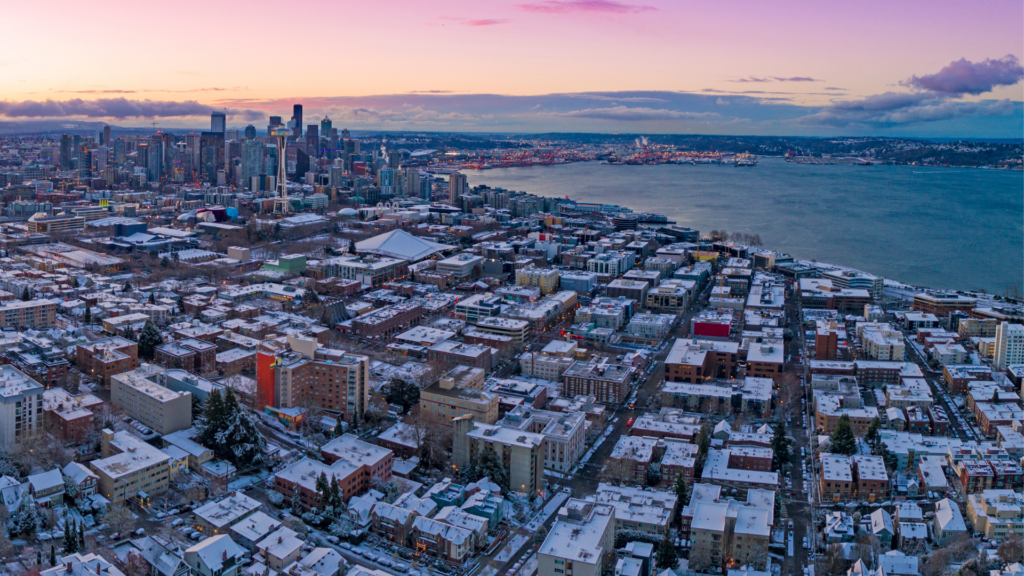The Regional Homelessness Authority plays a county-wide coordinating role, convening partners, calling for additional space to be opened, and gathering and sharing information when severe weather hits.
This January 10-17, 2024, Tier 3 Severe Weather Protocols were activated in response to several nights of overnight freezing temperatures, very low daytime temperatures, and the potential for lowland snow in the forecast.
When there is severe weather in the forecast for King County—a large geographic region with varied weather across subregions—many government agencies reallocate resources, staff time, and spring into action to respond to community needs. The King County Regional Homelessness Authority is one of those agencies—it is our role to coordinate the emergency response to severe weather to help protect as many people as possible from the impacts of the elements—right now, that’s cold, wind, rain, snow.
Throughout the community, severe weather activations are an all-hands-on-deck situation for local governments, non-profits that serve unhoused individuals and families, and many faith communities that open their doors to create additional shelter space as a respite from the cold.
How do we know when to activate?
We work alongside the National Oceanic and Atmospheric Administration and the National Weather Service – Seattle office to constantly monitor the weather. Thanks to the work of Tech4Housing, we have a tool that looks at the weather data and sends us automatic reports about the risk of severe weather in the forecast.
In the summer, that means looking at the risk for extreme heat and wildfire smoke. In the winter, we look at daytime and overnight temperatures, as well as rain and snow.
The CDC found that the risk of hypothermia is most likely in extreme cold, but it can also happen at temperatures above 40 degrees, especially when a person is chilled from rain.
Here are our cold weather activation thresholds:
- Tier 1: – Increased Outreach and Survival Supplies Distribution
- Daily high temperatures predicted at 45°F or below for 3 days (Apparent Temperature conditions, coupled with low temperatures, predict increased life-threatening conditions)
- Tier 2: Opening of Short-Term Emergency Shelters
- Daily high temperatures predicted at 40°F or below for 3 days and/or
- Daily low temperatures predicted at 35°F or below for 3 days and/or
- Snow or rain accumulation greater than 2 inches
- Tier 3: Expanded Emergency Operations
- Daily high temperatures predicted at 35°F or below for a single day and/or
- Daily low temperatures predicted at 30°F or below for a single day and/or
- Snow/rain accumulation greater than 4 inches
For example, with our current activation, predicted snow and rain accumulation totals do not meet our Tier 3 thresholds, but there are several days in the forecast with daily highs below 35°F and daily lows below 30°F, so we are currently in a Tier 3 activation.
Making the call to activate is complicated. Forecasts shift, and day-to-day forecasts may technically bounce between activation levels. In our current activation, the forecast showed conditions that meet Tier 3 activation levels for several days, with one day that meets Tier 2 thresholds couched in the middle of them—so KCRHA made the call to keep Tier 3 activation levels to create more stability in the response and consistent places for folks to go.
As climate change accelerates, severe weather events—extreme cold, heat, and unhealthy air—are happening with increasing frequency. KCRHA and partners are ready with an emergency response to help people experiencing homelessness survive severe weather, but it will take broad community action to prevent homelessness by recognizing housing as a basic human need.
What happens once an activation is approved?
While there are always people at the KCRHA working on severe weather—whether that’s monitoring the forecast, working with government and nonprofit partners to make the next activation better, or building better internal tools and protocols—when an activation is approved, it becomes an all-hands-on-deck situation.
Once the decision is made, KCRHA’s Subregional Planning Team and Programs Team begin reaching out to partners like local cities, government agencies, and non-profit organizations to give them a heads up about the coming activation and start gathering information on resources that will be available. Then, we send a follow-up email to local service providers in our Continuum of Care, officially announcing the activation and providing information and tools.
After non-profit shelter, outreach, and service providers and government partners have been notified, then we announce the activation to the media and the public.
Because we want to give as much time as possible to prepare, we often announce the activation before we’re able to fully update the resources on our Severe Weather Page. This is why you may notice a lag between when we announce an activation and when updated information is available.
Current, accurate information can be crucial for someone seeking shelter, which is why we gather fresh information from as many service providers as possible for every activation.
We work to confirm information from partners on details like which city-owned properties can open (e.g., Seattle City Hall or Seattle Center, or both), hours of operation, and bed capacity. Much of this activity happens in real time and the information gathering and local response coordination is done by KCRHA staff members who are re-deployed from their normal daily tasks to work on severe weather response.
Ongoing adjustments are made in real time as well. For example, in collaboration with the City of Seattle, Exhibition Hall opened with an expected capacity of 120, but was quickly expanded to 200 because of the need, and, once additional cots were secured, was again expanded to hold up to 300 people each night from January 13-16, 2024. Adjustments are coordinated, and information must be updated, every day.
As updated information comes in, we then update the Severe Weather page on the website—and continue to update that page every day as new information comes in, throughout the entire activation. Once we have made updates to all subregions on our website, with as up-to-date information as possible, we start creating regional flyers, social media graphics, and send a mass email to everyone on our email lists.
What happens during activations?
The activities that happen during activations are determined by the activation tier, and are always a significant undertaking by our entire community.
- Tier 1: – Increased Outreach and Survival Supplies Distribution
- Increased outreach through contracted providers and other formal and informal community groups to vulnerable unsheltered people
- KCRHA communication through email list-serv, scheduled and ad hoc meetings
- Geographic prioritization based on forecasted weather conditions
- Agencies can request funding for additional purchase of supplies, distribution of supplies, and increased navigation to get people inside
- Tier 2: Opening of Short-Term Emergency Shelters
- Everything in Tier 1, plus…
- Open temporary emergency shelters (also known as severe weather shelters), seek expansions to existing emergency shelter programs including 24/7 shelters and night-by-night shelters
- Support food distribution to temporary shelter sites
- Update communications materials including but not limited to KCRHA’s Severe Weather webpage, and flyers, to include up-to-date information
- Tier 3: Expanded Emergency Operations
- Everything in Tiers 1 and 2, plus…
- Coordination with transit and transportation partners to shelter sites
- Coordinate with cities to open local City-owned properties for warming centers and/or overnight shelters
- Support food distribution to shelter sites and day centers with a focus on snow-ready vehicles
- Open emergency daytime warming centers and day centers
As we move up in the tiers, response becomes more complicated, and requires more support from partner government agencies, non-profits, faith communities, and volunteers throughout the region.
During activations, KCRHA’s “Weather Emergency Response Crew” (WERC), works alongside local partners to help increase access to safe shelter, support our local programs and services, and keep information updated and accurate.
It is truly a community effort, and we are grateful that so many people care so deeply about the unsheltered in our community that they’re willing to work long hours in hard situations to activate this safety net during extreme weather.
What does the future of KCRHA’s Severe Weather Response look like?
We know that housing is the solution to homelessness. People experience homelessness all year long, and the health impacts of surviving outside are severe even when the temperatures are mild. Housing is a basic human need, and when our community provides more safe housing, we need less emergency shelter.
Extra shelter space during extreme weather helps meet the immediate need for warmth but does not solve the root cause. We know that the spaces we’re able to open during severe weather activations, while crucial, are insufficient, given the magnitude of homelessness in King County. We’ve improved our coordination with partners, but we know it’s not ideal to have shelters opening and closing all season long.
That’s why improving Severe Weather Response is a primary focus in years 1-2 of our 5 Year Plan.
We are already starting to see the fruits of that commitment. In December of 2022, five of the cities in North King County signed an Interlocal Agreement with the KCRHA, establishing formal collaboration to address homelessness in those cities. In November 2023, we awarded a grant to fund a severe weather shelter in North King County. This week, thanks to the collaboration and commitment of many individuals, agencies, and organizations, we were able to open the North King County Severe Weather Shelter, just in time for our current activation.
More collaboration like this, leading to expanding services, more people indoors, safer options during dangerous weather events, and more housing for all our neighbors are all part of the future of KCRHA’s Severe Weather Response.



